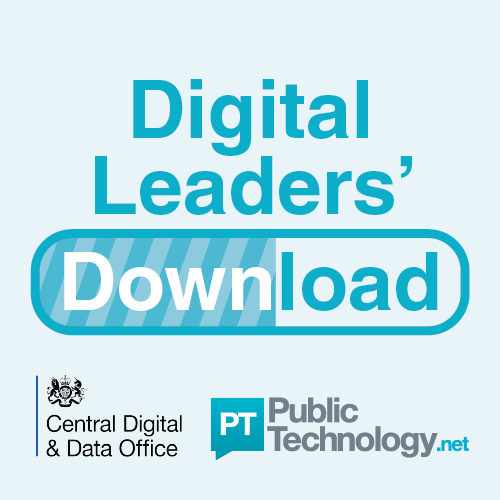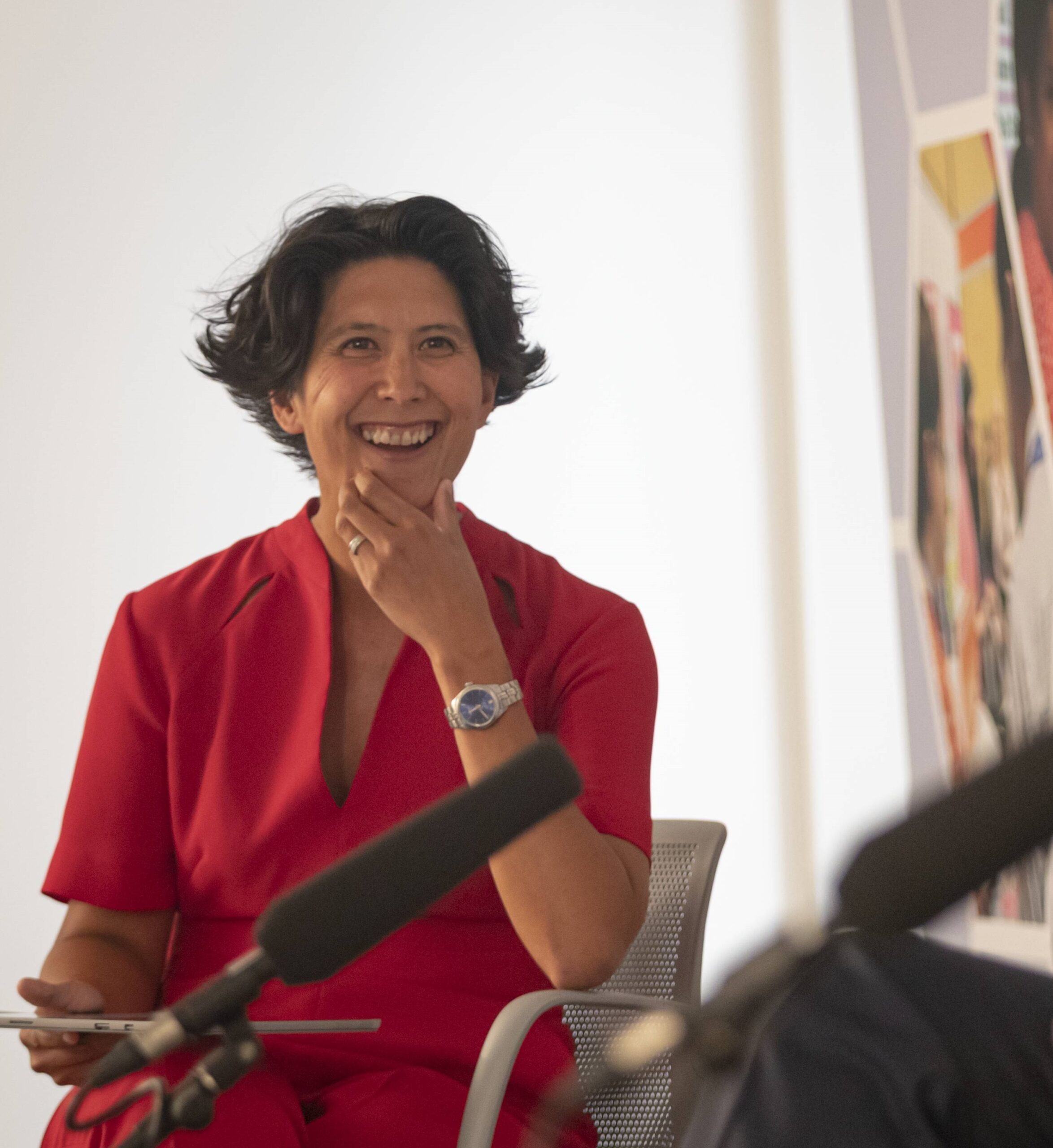As part of our series of interviews with some of government’s foremost leaders – published in partnership with CDDO – HM Treasury’s Cat Little discusses leadership, AI, and the upcoming spending review
Cat Little joined HM Treasury in 2020 as director general, public spending. Having joined the finance department right at the beginning of the coronavirus crisis, just a few months into her new role Little (pictured above) found herself running a government spending review from home, typically with “couple of dogs with me, causing chaos in the background”.
Despite such distractions, the public spending chief found “lots of positives” in conducting the process virtually. The experiences of 2020 and 2021 – which brought a full, three-year comprehensive spending review – “turbo-charged” the Treasury’s use of digital tools, according to Little.
She took on the role of acting permanent secretary in September 2022 and the following month was appointed to the post of second permanent secretary. In this role, she now oversees public spending, international and national security policy. She combines this with her positions as head of the Government Finance Function and Chair of the Finance Leadership Group for Government.
HM Treasury will next year publish a long-term Future of Finance strategy and, according to the second perm sec, will continue seek “innovative ways to deliver more and better outcomes through tech, data, AI and better use of our talented people’s time and energy”.
PublicTechnology is delighted to be working with the Cabinet Office’s Central Digital and Data Office on our ongoing Digital Leaders’ Download series of interviews with some of government’s most high-profile figureheads – both in the fields of digital, data and technology and beyond.
Having previously published interviews with the digital unit’s recently departed chief executive Megan Lee Devlin, former HM Prison and Probation Service leader Jo Farrar, and national statistician Sir Ian Diamond, this piece features a recent discussion between the former CDDO head and Little.
Megan Lee Devlin: Cat, while you are an accountant, senior civil servant and board member, you are also a very active supporter of the digital agenda. What does being a digital leader mean to you?
Cat Little: We are all digital leaders in government and we have a number of responsibilities, most importantly around culture and behaviours. Digital is a fundamental part of the way we do business in our day-to-day jobs. It’s our responsibility to look after policy, money, operational delivery, and digital is part of that. We don’t all need to be experts in digital but we do need to understand the expertise involved and know enough to role model putting digital at the heart of how we do our jobs.
I’m particularly interested at the moment in how we analyse large amounts of complex data for consistent decision making, including generative AI, complex data analysis models and large language models. These help us to give the right tools to decision makers, case workers and operational delivery teams on the ground.
Cat Little, HM Treasury
MLD: Absolutely – digital has become everyone’s business, irrespective of function or profession. I’m often asked how leaders can, in practice, role model digital leadership. How do you think about that? For instance, how do you hear and learn about new developments in technology?
CL: One of the great privileges of my job is that I get involved in every single bit of the economy and the public sector. I get to talk to organisations that are delivering innovation every day – that might be private companies, public sector bodies, international government – and I get to talk to leaders who really understand our problems.
I also read a lot in this space, there are great blogs and articles published all the time – exercising that normal civil service curiosity, and using our network and relationships to think differently about the challenges we face. So many people are using digital in different ways.
MLD: And we certainly face some of the most intractable challenges here in government. What excites you most about the role of digital and data in addressing some of those?
CL: We in the Treasury are grappling with big macroeconomic challenges for the economy as a whole and one of my passions is how do we go about delivering better services for the public sector overall. How can we be more productive? How can we be more effective? Digital thinking can be a win-win for everyone.
As we think about policy reform in the medium term for the next spending review, one of our core questions is: how can we better use data and digital for better service outcomes, what are the outputs we need to produce and can we do that with less resource? There are lots of ways for digital, data and technology to drive better outcomes for less resource input, that has to be a fundamental part of what we are doing.
The thing that I am most passionate about is the fact that we can radically shift the service outcomes we are seeking to achieve by using policy alongside digital and data transformation – to be more productive and efficient by default. The public sector is so huge. If you take a great innovation in, say, one hospital in the NHS, how do you scale that effectively to all 250 hospitals across England and Wales? We need to be able to scale opportunities as the best ideas happen locally.
MLD: The world is very excited about AI at the moment, and we know there are many other exciting developments on the horizon, such as quantum computing. What’s your favourite emerging technology?
CL: I’m particularly interested at the moment in how we analyse large amounts of complex data for consistent decision making, including generative AI, complex data analysis models and large language models. These help us to give the right tools to decision makers, case workers and operational delivery teams on the ground.
MLD: Absolutely, and I know that Treasury has been thinking a lot about how AI can support its own productivity and public sector productivity. What has your department achieved through digital and data that you are especially proud of?
CL: The Treasury is really proud of the progress we’ve made so far, particularly as we are not a big operational team – we are more policy-driven – and it has taken a bit longer to accelerate in this area. One thing we did recently was run our first data hackathon, where ten departments came together to look at generative AI to support our work on correspondence management. We are now looking at how we apply the solutions further across government collaboration – correspondence is a huge challenge for us and we are going to keep running these hackathons.
MLD: If we were to fast forward to 2025, what do you look forward to seeing in the digital and data space?
CL: There is so much going on at the moment to look forward to: improving our top 75 government services, improving the quality of data to make better decisions, as well as our promises on One Login and cross-cutting system reform. This is in addition to a strong civil service that has a strong digital and data skill set.
As I’ve already mentioned, it would also be great to see further integration of digital and data into policy making – all these things are underway as part of the Digital Transformation Roadmap.


Look out for more interviews in the Digital Leaders’ Download series in the coming weeks.
Catch up here on our interview with Lee Devlin – including insights into eliminating departments’ biggest legacy risks, unlocking £8bn of technology investment, and the rollout so far of government’s three-year digital strategy. Or here you can read her discussion with former HM Prison and Probation Service head Jo Farrar, including her thoughts on the potential of virtual reality and AI, and why it’s time for civil servants to stop accepting outdated IT. Lee Devlin’s discussion with national statistician professor Sir Ian Diamond can be read here, including insights from the ONS chief on how data can deliver “answers we could only have dreamed about 20 years ago”.





여행지
청도페이스라인출장
https://klero.tistory.com/tag/커플디데이어플후기
거제출장안마
아름다운스웨디시업소
https://pornmaster.fun/hd/富联娱乐☘EFB88F9797·me💓皇马娱乐天美娱乐☘EFB88F9797·me💓欧皇娱乐
https://pornmaster.fun/hd/tamil-actress-meena-sex-videosww-aunty-saree-sex-com-sexy-xxx-xxxx-mp4-girls-sexa-boy-anty-xxx-3gp-video-download-aunty-real-sexy-hipangla-move-hot-sex-shimla-songbollywood-qeenu-madhuri-dixit-ki-open-chut-aur-lund-ki-sexgopika-fake-xxxall-bengali-actress-nude-pussykodermapakistan-lahore-school-girl-in-school-bathroom-xxx-sexy-pron-2gpafrican-nigro-xxxhors-and-garl-fokig-esxtelugu-ants-aexdesi-aunty-hiking-up-saree-showing-assপপি-neked-photowww-desi-girl-big-boob-images-comamanna-nedu-naked-photodesi-aadivasi-haous-wife-jangal-pussy-fuking-photosbarsha-priyadarshini-nude-boob-sec-fuckingaletta-ocean-spy-hard-full-movi-downlodlhi-desi-school-teacher-sex-3gpla-2015-xxx-video-hd-downloadbengli-audioxxx-bangla-sexybangladeshi-xxx-video-20015bangla-hot-movesemini-iddamalgoda-sexsmallgirl-fuckindian-aunties-in-vegetable-market-videosdj-arafat-sax-hdtelugu-heroins-sex-vidoesgang-rap-xxxtamil-hot-xxxভাই-ও-বোনের-চুদার-si-village-aunty-outdoor-pissingvya-madavan-xxx12yers-xxx-girlsister-acc-fuckww-pornbindian-virgin-sex-pussy-blood-girl-xxxamil-actress-nagma-nude
https://pornmaster.fun/hd/xxmalu
Your point of view caught my eye and was very interesting. Thanks. I have a question for you.
Thanks for expressing your ideas in this article. The other factor is that any time a problem occurs with a laptop motherboard, people today should not have some risk with repairing that themselves because if it is not done correctly it can lead to irreparable damage to the whole laptop. It’s usually safe to approach your dealer of any laptop for the repair of motherboard. They will have technicians with an competence in dealing with laptop computer motherboard troubles and can have the right analysis and carry out repairs.
https://mrdeeply.tistory.com/280
대전호박나이트
벼룩시장 구인구직 및 신문 그대로 보기 (PC/모바일) | 구인구직 앱 어플 무료 설치 다운로드 | 모바일 벼룩시장 보는 방법 | 벼룩시장 부동산 | 지역별 벼룩시장 | 벼룩시장 종이신문 에 대해 알아보겠습니다. 섹스카지노사이트
Simply want to say your article is as astounding. The clarity to your submit is just great and that i could suppose you’re knowledgeable in this subject. Well together with your permission allow me to clutch your feed to stay up to date with forthcoming post. Thanks a million and please keep up the enjoyable work.
여행지
Thanks for the blog post, can you make it so I get an update sent in an email whenever there is a fresh article?
양산시술출장마사지
I抳e recently started a website, the information you offer on this site has helped me greatly. Thank you for all of your time & work.
https://itlearn.kr/
https://itgunza.com/3695
I love your websites but mine hd Chatoriclips sexy bf video is also good. Visit us
I have observed that of all types of insurance, medical insurance is the most questionable because of the discord between the insurance coverage company’s need to remain making money and the buyer’s need to have insurance plan. Insurance companies’ profits on well being plans are extremely low, hence some companies struggle to generate income. Thanks for the concepts you discuss through your blog.
https://ddnews.co.kr/blog/2023/03/05/chatgpt/
안성출장마사지
https://nicesongtoyou.com/tax/corporate-tax/
대전호박나이트
https://sportscom.co.kr/2023-fiba-world-cup/
https://chotiple.tistory.com/tag/다음팟인코더20동영상20편집
thanks for your effort mate. You are one of a kind. Keep kicking.
https://dnolife.net/category/software/
https://nicesongtoyou.com/health/hearing-aid/
Thanks for the suggestions shared on the blog. Something also important I would like to express is that weight reduction is not about going on a celebrity diet and trying to lose as much weight as you’re able in a few months. The most effective way to burn fat is by consuming it gradually and following some basic guidelines which can allow you to make the most from a attempt to shed weight. You may learn and already be following a few of these tips, although reinforcing understanding never does any damage.
Thanks a lot for the helpful content. It is also my belief that mesothelioma cancer has an particularly long latency time period, which means that signs of the disease may well not emerge right up until 30 to 50 years after the original exposure to asbestos. Pleural mesothelioma, that’s the most common form and impacts the area around the lungs, will cause shortness of breath, torso pains, and a persistent coughing, which may cause coughing up blood.
벼룩시장 구인구직 및 신문 그대로 보기 (PC/모바일) | 구인구직 앱 어플 무료 설치 다운로드 | 모바일 벼룩시장 보는 방법 | 벼룩시장 부동산 | 지역별 벼룩시장 | 벼룩시장 종이신문 에 대해 알아보겠습니다. 섹스카지노사이트
I just like the valuable information you provide for your articles. I will bookmark your blog and take a look at again here regularly. I am relatively certain I抣l be told lots of new stuff right right here! Good luck for the next!
Hey, you are doing great thanks for your effort and visit Odia sexy video
mexican drugstore online: Mexican Easy Pharm – Mexican Easy Pharm
https://new-software.download/windows/clovanote/
medication from mexico pharmacy https://mexicaneasypharm.shop/# Mexican Easy Pharm
mexico drug stores pharmacies
https://predpharm.com/# PredPharm
5 mg prednisone tablets
https://predpharm.shop/# PredPharm
prednisone 10 mg daily
https://kamapharm.com/# sildenafil oral jelly 100mg kamagra
generic prednisone online
https://predpharm.shop/# prednisone 80 mg daily
can you buy prednisone over the counter
I always thoroughly enjoy reading insightful posts that help businesses grow and succeed. If you’re looking to take team performance to the next level, check out Upleashed’s skills matrix tool at https://upleashed.com. It’s a game-changer for managing and developing team.
https://predpharm.shop/# can i buy prednisone over the counter in usa
15 mg prednisone daily
https://cytpharm.shop/# buy cytotec pills online cheap
1250 mg prednisone
https://predpharm.com/# prednisone 40 mg
10mg prednisone daily
https://farmaprodotti.shop/# Farmacie on line spedizione gratuita
п»їFarmacia online migliore
https://kakaotaxi.dasgno.com/page/4
대전세븐나이트
farmacia online https://farmaprodotti.shop/# farmacia online senza ricetta
farmacie online autorizzate elenco
https://farmabrufen.com/# FarmaBrufen
acquisto farmaci con ricetta
farmacie online affidabili: BRUFEN prezzo – Farmacie on line spedizione gratuita
farmacia online piГ№ conveniente
Game rules can vary between casinos.: taya777.icu – taya777
https://tiptravel.tistory.com/9
Resorts provide both gaming and relaxation options. https://taya777.icu/# Players can enjoy high-stakes betting options.
Players can enjoy high-stakes betting options.: taya777 – taya777 login
Players enjoy both fun and excitement in casinos.: taya365 – taya365 com login
The Philippines has several world-class integrated resorts. http://jugabet.xyz/# Las promociones atraen nuevos jugadores diariamente.
Most casinos offer convenient transportation options.: phmacao com – phmacao.life
Players can enjoy high-stakes betting options.: phtaya login – phtaya casino
Resorts provide both gaming and relaxation options.: phmacao – phmacao casino
https://www.ohgunstory.com/entry/EBA788ED81ACEB8BA4EC9AB4EC9CBCEBA19C-ED9484EBA6ACECA0A0ED858CEC9DB4EC8598-ED9598EAB8B0-MARP
Gambling can be a social activity here.: phtaya.tech – phtaya login
Most casinos offer convenient transportation options. http://phtaya.tech/# Game rules can vary between casinos.
The Philippines offers a rich gaming culture.: taya365.art – taya365
Players must be at least 21 years old.: taya777 app – taya777.icu